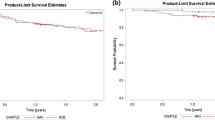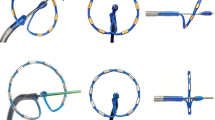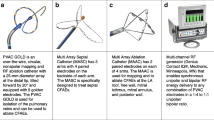Abstract
Purpose
Pulmonary vein isolation (PVI) is widely established as a curative treatment option for atrial fibrillation (AF). A wide range of techniques to improve catheter manipulation and steerability has been developed over the past years. A new remote catheter system (RCS) has recently become available (Amigo Remote Catheter System, Catheter Robotics, Budd Lake, NJ, USA). Here, we present a dual-center study on the RCS for left atrial mapping and PVI in patients with paroxysmal AF compared to a control group undergoing conventional PVI.
Methods
One hundred nineteen patients who underwent PVI for paroxysmal AF were studied. Forty patients underwent PVI with the use of the RCS. Seventy-nine patients, who underwent conventional PVI, served as control group. Procedural data were compared between the two groups.
Results
PVI was achieved in all patients. In the RCS group compared to standard ablation group, there were no significant differences in procedure duration (159.1 ± 45.4 vs. 146 ± 30.1 min, p = 0.19), total energy delivery (78,146.3 ± 26,992.4 vs. 87,963.9 ± 79,202.1 Ws, p = 0.57), and total fluoroscopy time (21.2 ± 8.6 vs. 23.9 ± 5.4 min, p = 0.15). Operator fluoroscopy exposure was significantly reduced in the RCS group (13.4 ± 6.1 vs. 23.9 ± 5.4 min, p < 0.001).
Conclusions
These initial results suggest that left atrial mapping and PVI are feasible with the use of the Amigo RCS. Acute procedural efficacy is comparable to the standard approach. The use of the Amigo RCS leads to a significant reduction of operator fluoroscopy exposure.

Similar content being viewed by others
References
Camm, A. J., Lip, G. Y., De Caterina, R., Savelieva, I., Atar, D., Hohnloser, S. H., et al. (2012). 2012 focused update of the ESC guidelines for the management of atrial fibrillation: an update of the 2010 ESC Guidelines for the management of atrial fibrillation * Developed with the special contribution of the European Heart Rhythm Association. European Heart Journal, 33(21), 2719–47.
Calkins, H., Kuck, K. H., Cappato, R., Brugada, J., Camm, A. J., Chen, S. A., et al. (2012). 2012 HRS/EHRA/ECAS expert consensus statement on catheter and surgical ablation of atrial fibrillation: recommendations for patient selection, procedural techniques, patient management and follow-up, definitions, endpoints, and research trial design. Journal of Interventional Cardiac Electrophysiology, 33, 171–257.
Ouyang, F., Antz, M., Ernst, S., Hachiya, H., Mavrakis, H., Deger, F. T., et al. (2005). Recovered pulmonary vein conduction as a dominant factor for recurrent atrial tachyarrhythmias after complete circular isolation of the PVs: lessons from double Lasso technique. Circulation, 111, 127–35.
Neuzil, P., Reddy, V. Y., Kautzner, J., Petru, J., Wichterle, D., Shah, D., et al. (2013). Electrical reconnection after pulmonary vein isolation is contingent on contact force during initial treatment: results from EFFICAS I study. Circulation Arrhythmia and Electrophysiology, 6, 327–33.
Nguyen, B. L., Merino, J. L., & Gang, E. S. (2010). Remote navigation for ablation procedures—a new step forward in the treatment of cardiac arrhythmias. European Cardiology, 6, 50–6.
Malcolme-Lawes, L. C., Lim, P. B., Koa-Wing, M., Whinnett, Z. I., Jamil-Copley, S., et al. (2013). Robotic assistance and general anaesthesia improve catheter stability and increase signal attenuation during atrial fibrillation ablation. Europace, 15(1), 41–7.
Wutzler, A., Rolf, S., Huemer, M., Parwani, A. S., Boldt, L. H., Herberger, E., et al. (2012). Safety aspects of deep sedation during catheter ablation of atrial fibrillation. Pacing and Clinical Electrophysiology, 35, 38–43.
Di Biase, L., Wang, Y., Horton, R., Gallinghouse, G. J., Mohanty, P., Sanchez, J., et al. (2009). Ablation of atrial fibrillation utilizing robotic catheter navigation in comparison to manual navigation and ablation: single-center experience. Journal of Cardiovascular Electrophysiology, 20(12), 1328–35.
Rillig, A., Meyerfeldt, U., Kunze, M., Birkemeyer, R., Miljak, T., Jäckle, S., et al. (2010). Persistent iatrogenic atrial septal defect after a single-puncture, double-transseptal approach for pulmonary vein isolation using a remote robotic navigation system: results from a prospective study. Europace, 12(3), 331–6.
Yamada, T., McElderry, H. T., Epstein, A. E., Plumb, V. J., & Kay, G. N. (2007). One-puncture, double-transseptal catheterization manoeuvre in the catheter ablation of atrial fibrillation. Europace, 9(7), 487–9.
Nölker, G., Gutleben, K. J., Muntean, B., Vogt, J., Horstkotte, D., Dabiri Abkenari, L., et al. (2012). Novel robotic catheter manipulation system integrated with remote magnetic navigation for fully remote ablation of atrial tachyarrhythmias: a two-centre evaluation. Europace, 14(12), 1715–8.
Hlivák, P., Mlčochová, H., Peichl, P., Cihák, R., Wichterle, D., & Kautzner, J. (2011). Robotic navigation in catheter ablation for paroxysmal atrial fibrillation: midterm efficacy and predictors of postablation arrhythmia recurrences. Journal of Cardiovascular Electrophysiology, 22(5), 534–40.
Saliba, W., Reddy, V. Y., Wazni, O., Cummings, J. E., Burkhardt, J. D., Haissaguerre, M., et al. (2008). Atrial fibrillation ablation using a robotic catheter remote control system: initial human experience and long-term follow-up results. Journal of the American College of Cardiology, 51(25), 2407–11.
Kanagaratnam, P., Koa-Wing, M., Wallace, D. T., Goldenberg, A. S., Peters, N. S., & Davies, D. W. (2008). Experience of robotic catheter ablation in humans using a novel remotely steerable catheter sheath. Journal of Interventional Cardiac Electrophysiology, 21(1), 19–26.
Khan, E. M., Frumkin, W., Ng, G. A., Neelagaru, S., Abi-Samra, F. M., Lee, J., et al. (2013). First experience with a novel robotic remote catheter system: Amigo™ mapping trial. Journal of Interventional Cardiac Electrophysiology, 37(2), 121–9.
López-Gil, M., Salgado, R., Merino, J.L., Datino, T., Figueroa, J., Arenal, A., et al. (2013). Cavo-tricuspid isthmus radiofrequency ablation using a novel remote navigation catheter system in patients with typical atrial flutter. Europace.
Author information
Authors and Affiliations
Corresponding author
Rights and permissions
About this article
Cite this article
Wutzler, A., Wolber, T., Parwani, A.S. et al. Robotic ablation of atrial fibrillation with a new remote catheter system. J Interv Card Electrophysiol 40, 215–219 (2014). https://doi.org/10.1007/s10840-014-9895-x
Received:
Accepted:
Published:
Issue Date:
DOI: https://doi.org/10.1007/s10840-014-9895-x




